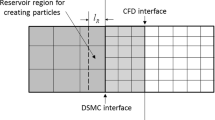Abstract
ELPIC, a macroparticle code for modeling complex nonstationary inhomogeneous compressible flows is described and demonstrated. It operates with Langrangian-type finite-sized rectangular particles with adjustable sizes. The dimensions of the particles smoothly adjust to peculiarities of the flow in order to minimize overlapping and gaps between the particles. The particles can divide in rarefaction waves to smoothly cover the simulated flow area. The particles carry mass, which is constant between divisions, and a number of chemical and thermodynamical properties of the substance they represent, including the index of the equation of state, chemical composition, mechanical properties, etc. The ELPIC approach combines the essential advantages of both Eulerian and Langrangian approaches, and overcomes the difficulties encountered by Nishiguchi and Yabe in their well-known code SOAP, based on conceptually similar principles.
Similar content being viewed by others
References
Amsden, A. (1966). The Particle-in-Cell method for the calculation of the dynamics of compressible fluids.Los Alamos Scientific Laboratory Report LA-3466.
Amsden, A.A., Ruppel, H. M., and Hirt, C. W. (1980). SALE: A Simplified ALE Program for Fluid Flow at All Speeds. Los-Alamos Report LA-8095, pp. 33–36.
Barnes, D C., Kamimura, T., Leboeuf, J.-N., and Tajima, T. (1983). Implicit Particle Simulation of Magnetized Plasmas.Journal of Computational Physics 52, 480–502.
Book, D. L., Boris, J. P., and Nain, K. (1975). Flux-Corrected Transport-II: generalization of the method.Journal of Computational Physics 18, 248–283.
Brackbill, J. U. (1991). FLIP MHD: A particle-in-Cell method for magnetohydrodynamics.Journal of Computational Physics 96, 163–192.
Brackbill, J U. (1988). The ringing instability in Particle-in-Cell calculations of low-speed flow.Journal of Computational Physics 75, 469–492.
Brackbill, J U., and Ruppel, H. M. (1986). FLIP: a method for adaptively-zoned, Particle-in-Cell calculation of fluid flows in two dimensions.Journal of Computational Physics 65, 314–343.
Brunel, F., Leboeuf, J. N., Tajima, T., Dawson, J. M., Makino, M., and Kamimura, Y. (1981). Magnetohydrodynamic particle code: Lax-Wendroff algorithm with finer grid interpolations.Journal of Computational Physics 43, 268–288.
Evans, M. W., and Harlow, F. H. (1957). The Particle-in-Cell method for hydrodynamic calculations. Los Alamos Scientific Laboratory Report LA-2139.
Haas, J.-F., and Sturtevant, B. (1987). Interaction of weak shock waves cylindrical and spherical gas inhomogeneities.Journal of Fluid Mechanics 181, 41–76.
Harlow, F. H., Dickman, D. O., Harris, D. E., and Martin, R. E. (1959). Two-dimensional hydrodynamic calculations. Los Alamos Scientific Laboratory Report, LA-2301.
Marder, B. M. (1975). GAP-a PIC-type Fluid Code,Mathematics of Computation 29, (130), 434–446.
Matsumoto, M., and Kawata, S. (1990). TRIPIC: Triangular-Mesh Particle-in-Cell Code.Journal of Computational Physics 87, 488–493.
Nishiguchi, A., and Yabe, T. (1982). Finite-sized fluid particle in a nonuniform moving grid.Journal of Computational Physics 47, 297–302.
Nishiguchi, A., and Yabe, T. (1983). Second-Order Fluid Particle Scheme.Journal of Computational Physics 52, 390–413.
Nishiguchi, A., Orii, S., and Yabe, T. (1985). Vector Calculation of Particle Code.Journal of Computational Physics 61, 519–522.
Picone, J. M., and Boris, J. P. (1988). Vorticity generation by shock propagation through bubbles in a gas.Journal of Fluid Mechanics 189, 23–52.
Takewaki, H., Nishiguchi, A., and Yabe, T. (1985). Cubic Interpolated Pseudo-particle Method (CIP) for solving Hyperbolic-Type Equations.Journal of Computational Physics 61, 261–268.
Viechinski, D. J., Slavin, M. J., and Kliman, M. (1991).American Ceramic Society Bulletin 70, 1035–1039.
von Neumann, J., and Richtmyer, R. D. (1950).Journal of Applied Physics 21, 232.
Author information
Authors and Affiliations
Rights and permissions
About this article
Cite this article
Konstantinov, A.B., Orszag, S.A. Extended Lagrangian particle-in-cell (ELPIC) code for inhomogeneous compressible flows. J Sci Comput 10, 191–231 (1995). https://doi.org/10.1007/BF02089950
Received:
Issue Date:
DOI: https://doi.org/10.1007/BF02089950




